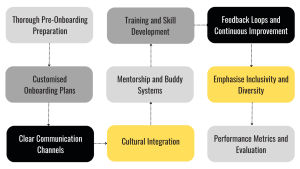Onboarding for Augmented Teams
Introduction Organisations are increasingly turning to augmented teams to enhance their capabilities and meet the demands of a rapidly evolving market. Augmented, or dedicated...

Introduction
Organisations are increasingly turning to augmented teams to enhance their capabilities and meet the demands of a rapidly evolving market. Augmented, or dedicated, teams consisting of both in-house and remote members, offer a unique blend of skills, perspectives, and diversity that can drive innovation and productivity. However, the success of such teams hinges on a well-executed onboarding process, ensuring seamless integration and collaboration. In this article, we will delve into the essential guidance for integrating augmented teams effectively, fostering a collaborative environment, and ensuring a smooth transition.
Understanding Augmented Teams
Before diving into the onboarding process, it’s crucial to have a clear understanding of what augmented teams are and how they differ from traditional teams. Augmented teams typically consist of in-house employees working alongside remote or external experts, freelancers, or specialists. This blending of internal and external talent brings a unique set of challenges and opportunities that require careful consideration during the onboarding process.

Thorough Pre-Onboarding Preparation
The success of onboarding dedicated team members begins before their first day. Provide detailed orientation materials, including company culture, mission, and values, to familiarise them with your organisation. Ensure that all necessary tools, software, and access permissions are set up in advance to avoid delays and frustrations on the first day.
Customised Onboarding Plans
Recognise the diverse backgrounds and experiences of augmented team members by creating customised onboarding plans tailored to their roles and responsibilities. Consider the specific skills and expertise they bring to the table and design a comprehensive onboarding program that addresses their unique needs.
Clear Communication Channels
Establish clear communication channels to facilitate seamless interactions within the dedicated team. Utilise collaboration tools, instant messaging platforms, and video conferencing solutions to bridge the gap between in-house and remote members. Clearly define expectations regarding communication frequency, preferred channels, and response times to avoid misunderstandings.
Cultural Integration
Foster a sense of belonging and cultural integration by actively involving augmented team members in team-building activities, both virtual and in-person when possible. Encourage participation in company events, meetings, and social gatherings to strengthen relationships and build camaraderie among team members.
Mentorship and Buddy Systems
Assign mentors or buddies from the existing in-house team to help augmented team members navigate the company culture, processes, and day-to-day activities. This personalised support system can significantly accelerate the integration process and provide a go-to resource for questions and concerns.
Training and Skill Development
Invest in continuous training and skill development programs to ensure that augmented team members stay abreast of industry trends and align with the evolving needs of the organisation. Provide access to relevant training resources, workshops, and mentorship opportunities to foster professional growth and development.
Feedback Loops and Continuous Improvement
Establish regular feedback loops to gather insights from both augmented and in-house team members. Use this feedback to identify areas for improvement in the onboarding process and overall collaboration. Embrace a culture of continuous improvement, making necessary adjustments to enhance the effectiveness of the augmented team integration.
Emphasise Inclusivity and Diversity
Promote an inclusive and diverse environment within the dedicated team by acknowledging and valuing the different perspectives, backgrounds, and experiences each member brings. Emphasise the importance of mutual respect and collaboration, creating a space where everyone feels heard and appreciated.
Performance Metrics and Evaluation
Implement clear performance metrics and evaluation criteria to assess the effectiveness of augmented team members within the organisation. Regularly review these metrics and provide constructive feedback to encourage continuous improvement and alignment with organisational goals.
Conclusion
Augmented teams have become indispensable for organisations seeking a competitive edge. The success of these teams relies heavily on effective onboarding strategies that seamlessly integrate external talent into existing in-house structures. By understanding the unique dynamics of augmented teams, customising onboarding plans, fostering clear communication, and promoting a culture of inclusivity and continuous improvement, organisations can unlock the full potential of their augmented teams, driving innovation, collaboration, and overall success.